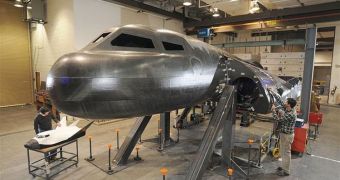Officials at the Sierra Nevada Corporation (SNC) Space Systems announce that their Dream Chaser spacecraft has recently completed a captive carry test successfully. The vehicle is being developed for both suborbital and orbital missions.
The spacecraft – which as a lifting-body design – is being developed under the NASA Commercial Crew Development (CCDev) and Commercial Orbital Transportation Services (COTS) contracts.
This Tuesday, May 26, SNC engineers attached a trial version of the Dream Chaser to an Erickson Air-Crane helicopter. The purpose of this maneuver was to assess the aerodynamic flight performances of the spacecraft as it traveled through the atmosphere.
When a full version of the vehicle is developed, it will have to undergo a series of drop tests. Sierra Nevada has already signed an agreement with Virgin Galactic, which allows the former to use the WhiteKnightTwo platform for these tests.
For the time being, SNC engineers need to ensure that their vertical-takeoff, horizontal-landing (VTHL) vehicle performs nominally in the atmosphere. Tuesday's flight occurred around the Rocky Mountain Metropolitan Airport, in Jefferson County, Colorado.
When completed, the reusable Dream Chaser will be able to carry up to 7 astronauts to targets in low-Earth orbit, including the International Space Station (ISS). Unlike other designs NASA is currently financing, this is the only space plane that can land on a runway, like the shuttles did.
“The successful captive carry flight test of the Dream Chaser full scale flight vehicle marks the beginning of SNC's flight test program, a program that could culminate in crewed missions to the International Space Station for NASA,” former NASA astronaut, Steve Lindsey, said.
He is currently the head of Dream Chaser's flight operations at SNC. “This is a very positive success for the Dream Chaser team and their innovative approach,” NASA CCP program manager Ed Mango added.
“I applaud and encourage the designers and engineers to continue their efforts in meeting the objectives of the rest of their CCDev2 milestones,” Mango went on to say.
When regular operations begin, the Dream Chaser will be carried into orbit aboard Atlas V delivery systems provided by the United Launch Alliance, a collaborative effort between Boeing and Lockheed Martin.
NASA reports that all companies working under COTS and CCDev contracts are meeting their respective milestones on time.

 14 DAY TRIAL //
14 DAY TRIAL //